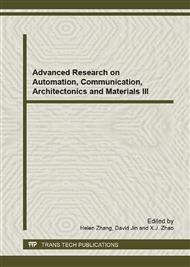[1]
Gong Qingbo. Current research situation of arthroidal cartilage injury and repair[J]. Journal of Clinical Rehabilitative Tissue Engineering Research, 2010, 14(24): 4491-4494.
Google Scholar
[2]
Wei Liu, Yilin Cao. Application of scaffold materials in tissue reconstruction in immunocompetent mammals: Our experience and future requirements[J]. Biomaterials, 2007, 28: 5078-5086.
DOI: 10.1016/j.biomaterials.2007.07.028
Google Scholar
[3]
Qiang Lv, Kun Hu, Fuzhai Cui, etc. Preparation and characterization of PLA/fibroin composite and culture of HepG2 (human hepatocellular liver carcinoma cell line) cells[J]. Composites Science and Technology, 2007, 67: 3023-3030.
DOI: 10.1016/j.compscitech.2007.05.003
Google Scholar
[4]
Chen Zhengrong. Research advances of cartilage tissue engineering and cell adhesion[J]. 2007, 24(10): 1279-1280.
Google Scholar
[5]
Zhang Wenqing, Shu Bingjun, Zhang Qiu, Huang Wenliang, Hu Xiaoling. Comparison of cartilage repair materials[J]. Journal of Clinical Rehabilitative Tissue Engineering Research. 2011, 15(8): 1495-1498.
Google Scholar
[6]
Han Ningbo. The development of scaffolds in cartilage tissue engineering[J]. J Med Postgra. 2010, 23(1): 94-96.
Google Scholar
[7]
Cheung HY, Lau KT, Lu TP, et al. A critical review on polymer-based bio-engineered materials for scaffold development[J], Composites: Part B, 2007, 38(3); 291-300.
DOI: 10.1016/j.compositesb.2006.06.014
Google Scholar
[8]
Gao S, Nishinari K. Effect of deacetylation rate on gelation kinet ics of konjac glucomannan. Colloids Surf B Biointerfaces, 2004, 38(3-4): 241~249.
DOI: 10.1016/j.colsurfb.2004.02.026
Google Scholar
[9]
Bin Li, Bijun Xie, John F. Kennedy. Studies on the molecular chain morphology of konjac glucomannan. Carbohydrate Polymers, 2006, 64: 510~515.
DOI: 10.1016/j.carbpol.2005.11.001
Google Scholar
[10]
Pang Jie, Lin Qiong. Progress in the Application and Studies on Functional Material of Konjac Glucomannan[J]. Chinese J. Struct. Chem. 2003, 11(6): 633~642.
Google Scholar
[11]
Tang J-L, et al. The anti-inflammatory effects of apocynin, inhibitor of NADPH oxidase, contrasting hyaluronic acid on articular cartilage during the development of osteoarthritis in a rabbit model[J], Biomedicine & Pharmacotherapy , (2010).
DOI: 10.1016/j.biopha.2010.08.002
Google Scholar
[12]
Kang S-W, et al. Surface modification with fibrin/hyaluronic acid hydrogel on solid-free form-based scaffolds followed by BMP-2 loading to enhance bone regeneration[J], Bone, 2011, 48: 298-306.
DOI: 10.1016/j.bone.2010.09.029
Google Scholar
[13]
Wang Shuhong, Cai Jiye, Hu Yi. Research on Hyaluronic Acid and Pectin Complex[J]. Journal of Biomedical Engineering, 2009, 26(3): 561-565.
Google Scholar
[14]
Lei Ming, Liu Shiqing, Liu Yulan, Wang Zhe, Peng Hao. Hyaluronic acid protects tissue engineering cartilage from the inhibitory effect of nitroprusside sodium[J]. Chin J Rheumatol, 2008, 12(10): 684-687.
Google Scholar
[15]
Kokubo T, Takadama H. How useful is SBF in predicting in vivo bone bioactivity?. Biomaterials 2006, 27(15): 2907-2915.
DOI: 10.1016/j.biomaterials.2006.01.017
Google Scholar


